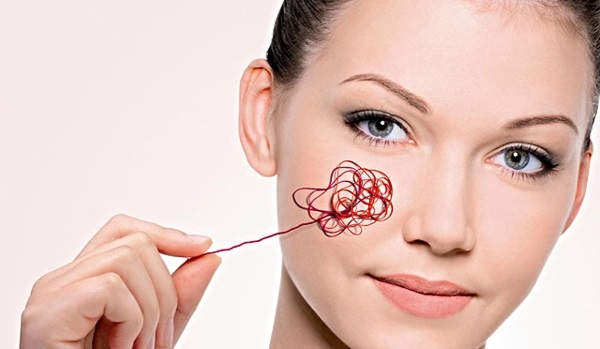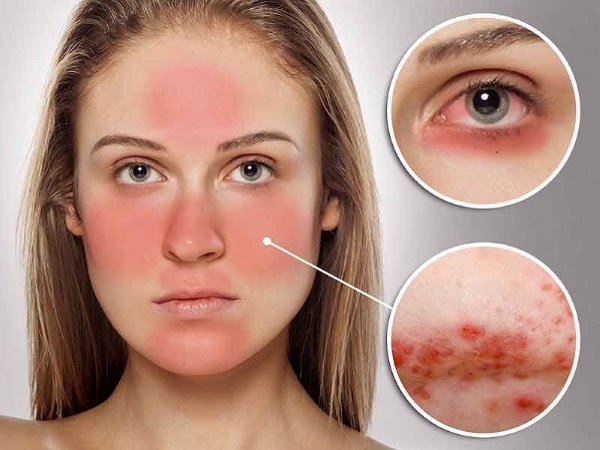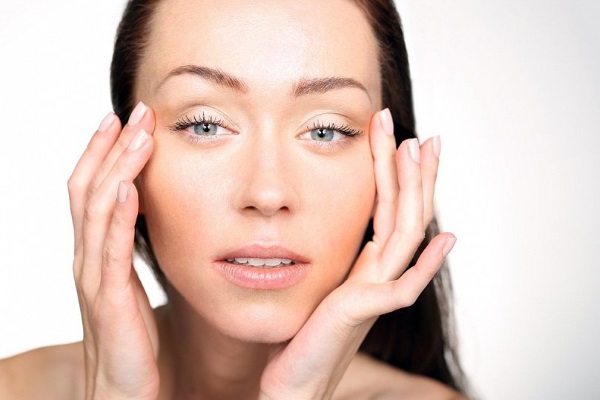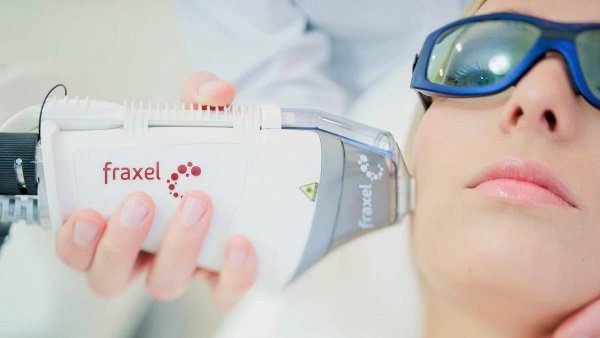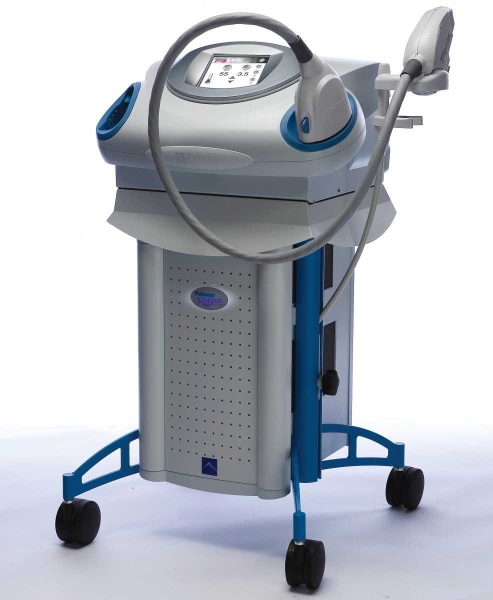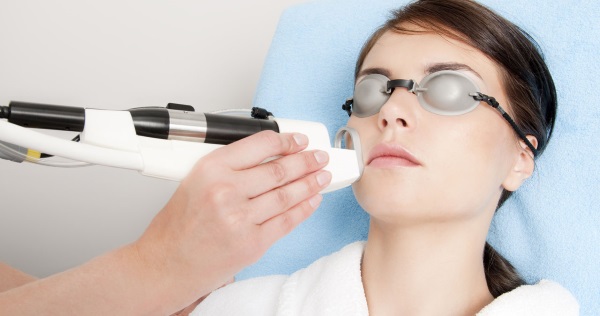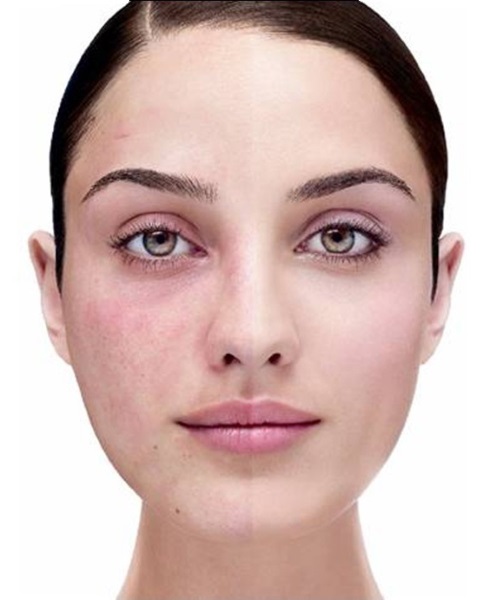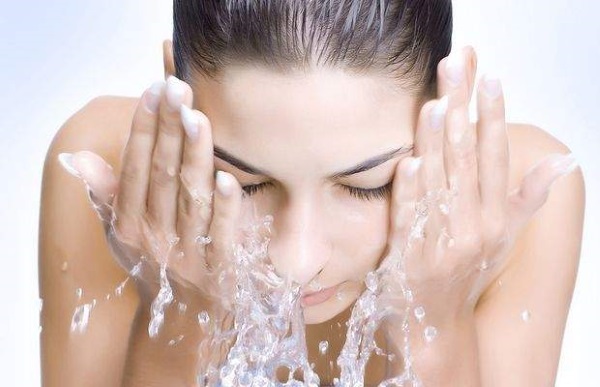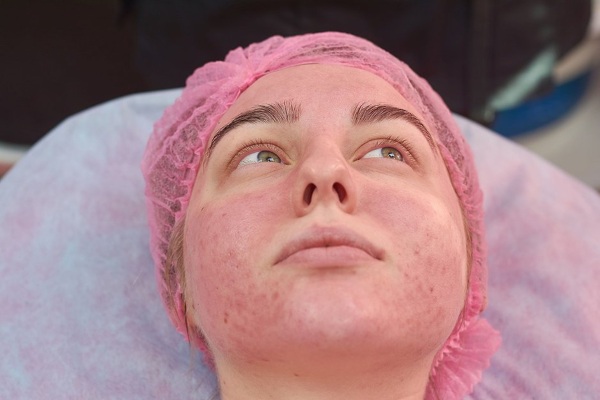Removing the mesh from dilated capillaries on the face using the method of laser coagulation is one of the most popular procedures in medical cosmetology. The technology implies a directed effect on small vessels of the thermal energy of a laser beam with a certain wavelength. At the same time, the laser selectively acts on damaged vessels without affecting healthy ones.
What problems does laser removal of spider veins, meshes solve?
Changes in the tone of the vascular walls and their loss of elasticity leads to a permanent expansion of the capillaries. Visually, this manifests itself as streaks of purple, red or purple, clearly visible through the skin. They form foci of redness on the face: vascular telangiectasias (the so-called "stars", "nets" and "spiders") and pinpoint lesions.
Most often, this defect appears on the wings of the nose, cheeks and chin. The expansion of small vessels is not dangerous to health, but it worsens the appearance of the face and promotes early skin aging. Capillaries are the smallest vessels associated with arteries and veins. They deliver nutrients and oxygen to tissues, taking away waste products from there.
When the normal functioning of the capillaries is disrupted, the skin experiences a nutritional deficiency. She begins to age much more intensively than nature intended. Under the influence of the laser, the damaged vessels are soldered; thus they leave the bloodstream and become part of the connective tissue.
Over time, new pathways are formed for blood circulation, through which the skin again receives the necessary substances.
Removal of capillaries on the face using laser coagulation eliminates the aesthetic disadvantage. The procedure returns a healthy youthful appearance to the skin in a short time, evens the complexion. The patient gains a sense of satisfaction with his appearance, which improves his quality of life.
Indications for the procedure
The purpose of laser correction is to remove vascular defects on the face, and the indication for the procedure is their presence.
Laser treatment is used when:
- The vasodilation takes on a persistent character.
- A visible vascular pattern appears.
The reason for such conditions is the violation of normal blood circulation, as well as the loss of the necessary elasticity by the vascular walls. When expanding, the fragile walls of blood vessels burst, obtaining defects with varying degrees of damage.
Persistent dilatation of small vessels accompanies diseases such as:
- rosacea;
- rosacea;
- "Wine stains".
With rosacea, the contractile ability of the capillary walls is impaired. The initial stage of the disease is manifested by focal redness on the skin (erythematosis), accompanied by itching and burning. Visible vascular patterns then appear. Microcirculation of blood is disturbed, the sensitivity of the skin worsens.An uneven complexion and other signs of premature aging appear.
The disease has a nature similar to varicose veins - weak vessel walls. Thin sensitive skin and the superficial location of capillaries also contribute to the appearance of pathology.
Rosacea occurs in middle and old age, more often in women. In the beginning, as with rosacea, persistent skin redness, itching and burning appear. Against its background, small inflammatory rashes (rosacea) and telangiectasias occur.
The occurrence of rosacea and rosacea is associated with vegetative-vascular neurosis, disorders of the digestive tract, ovarian dysfunction in women. Attacks provoke a number of temperature factors: sun, wind, frost. Alcohol abuse, in which there is a rush of blood to the skin of the face, and passion for bath procedures also play a negative role.
“Port wine stains” are flat vascular formations with indistinct borders, resembling in shape a stain from spilled wine. Essentially, this is an accumulation of a large number of dilated capillaries covered with a layer of the epidermis. Most often this is a congenital pathology.
Before removing the defect with a laser, the dermatologist will conduct a series of studies to accurately determine the nature of the nevus, the boundaries of the lesion and the volume of the upcoming procedures. Removing dilated capillaries, the laser affects the external manifestations of the disease. In some cases, this is not enough: systemic lesions of the body can be hidden behind the vascular patterns on the face.
If rosacea is considered a "cosmetic" form of varicose veins and does not pose a threat to health, then rosacea is inflammatory in nature and requires additional treatment.
In addition to local elimination of telangiectasias, it is necessary to correct concomitant vascular diseases, digestive and hormonal disorders. In severe cases, for the treatment of rosacea, the doctor prescribes tetracycline antibiotics.
Contraindications to laser removal
Removing capillaries from the face with a laser rarely causes complications.
However, there are a number of contraindications to the procedure:
- Infectious and acute inflammatory skin diseases.
- Oncological diseases.
- Photodermatitis (hypersensitivity to ultraviolet radiation; manifested by a rash on the skin after sun exposure).
- Artificial or sun tanning obtained by the patient less than 3 weeks before the procedure.
- Cardiovascular diseases in the stage of decompensation.
- Non-medicated diabetes mellitus;
- Pregnancy and lactation period.

Doctors do not recommend laser treatment in summer: during this period, exposure to UV rays is too aggressive. At the preliminary consultation, the doctor will individually assess the existing risks to the patient's health, taking into account the existing diseases.
Method advantages
Before the widespread use of laser coagulation, electric current and liquid nitrogen were used. These techniques did not completely solve the problem: there were often visible scars on the skin.
Cosmetic procedures were not effective enough. Due to its ability to act selectively and targeted, the laser has a number of advantages over other methods of eliminating vascular defects.
For instance:
- Leaves no scars.
- Does not damage the surrounding tissue.
- Removes even the smallest vessels that are resistant to other minimally invasive methods, including microsclerotherapy.
- There is no risk of infection.
- A long course is not needed, as with electrocautery (exposure to electric current).
- The procedure is almost painless.
- Instant effect: the vessels dissolve already during the procedure, and after a day or two you can see how the skin tone evens out.
The procedure is usually well tolerated by patients and does not require a long recovery period.
Cons of the procedure
With the correct procedure, the negative consequences are minimal.
However, there are the following disadvantages of laser coagulation:
- Several sessions are required to remove large vessels and treat large lesions.
- After the procedure, peeling occurs on the treated areas of the skin.
- It is not always possible to remove “wine stains” completely.
- For some time, the face remains swollen and red.
Some patients note that swelling and redness persist for 2 or more weeks. There are reviews where they report that the vasodilation has reappeared, and even in a larger volume than it was. Indeed, with the wrong choice of wavelength, incomplete coagulation of blood vessels may occur, followed by restoration of the vascular bed.
Types of devices for capillary laser therapy on the face
When choosing a device for laser therapy, the clinic doctor is guided by the following parameters:
- Light spot diameter... The selection depends on the size of the problem vessel.
- Radiated wavelength... Determined by the depth of the vessels. To coagulate the surface capillaries on the face, the waves of the green and yellow spectra (490–600 nm) are sufficient.
- Light pulse duration... Minimum is preferable: the treated vessel should not have time to give up some of the heat to the surrounding tissues. Otherwise, there is a risk of burn injuries.
- Continuous operation or pulse... Short pulses are safer: the tissue has time to cool between flashes, thus avoiding burns. Working with long pulse equipment has its advantages, but requires additional cooling. However, this problem has been solved in modern installations.
The correct choice of the device and setting the parameters in accordance with the nature of the forthcoming procedure will ensure good effectiveness of the effect and the minimum probability of complications.
The following types of laser equipment are used:
| Machine type | Wavelength, spectrum | The purpose of the impact | Features: | disadvantages |
| Pulsed dye laser (rhodamine is now used as a dye) | 585nm and 595nm (yellow-orange spectrum light) | Teleangi-ectasias, port wine stains, capillary hemangiomas | Removes superficial small vessels, penetrating 0.2 mm deep. Suitable for coagulation of small red capillaries on the face | Requires additional cooling of the skin surface. Hyperpigmentation is possible in dark-skinned patients |
| Pulsed copper vapor laser | 511 nm (green) and 578 nm (yellow) | Superficial vessels and age spots | It works in a complex way: green light is used to treat telangi-oectasias, yellow light is used for areas with impaired pigmentation. Preferred for killing dilated facial capillaries | Risk of tissue overheating. Possible pigmentation disorders, blisters and multiple crusts in patients with dark skin |
| Nd: YAG neodymium laser. Working medium: garnet with the addition of neodymium | 1064 nm (near infrared spectrum) | Superficial and deep-seated vessels, large and small | Penetration depth up to 8 mm. Suitable for working on all areas of the body and for all skin color types. Preferred for the removal of venous vessels | Smooth continuous impulse requires high energies to operate; there is a risk of scarring |
| Diode | 800-810 nm (infrared) | Red and blue vessels, purple capillaries | Perfectly removes fine capillary reticulum (rosacea, rosacea) and hematomas. Suitable for all skin colors | Not recommended for sensitive skin |
| KTP lasers. Functions simultaneously on neodymium and KTP crystal | 532 nm (green) | Telean-hyectases, wine stains, pigmentation disorders | Optimal for rosacea | In people with dark skin, it will cause pigmentation disorders |
Experts prefer installations that combine different types of radiation and multi-modular platforms
Which laser is better?
Often, solving a specific patient problem requires working with several types of laser.
Ideally, each clinic should have different types of laser equipment, and this is expensive.
Among the main preferences: expensive neodymium installations Palomar (USA) and KTP ND: Yag (Sweden).
The problem of tissue overheating is solved due to the built-in contact cooling system.
However, pulsed lasers operating on dyes or on copper vapors cope with dilated vessels on the face quite well.
To remove rosacea, the diode laser Quadro (Germany) is successfully used.
Most installations have interchangeable nozzles, which allows you to individually select the depth of exposure to the beam for each case. It is possible to set the desired intensity.
Preparation for the procedure
No special preparation for a laser coagulation session is required. At the preliminary appointment, the doctor will examine the patient's face and select the appropriate parameters for the procedure.
When coming to the procedure, you should not use makeup and wipe your face with alcohol solutions. Sunburn and chemical peels should be avoided 2-3 weeks before the session. It is worth being careful about taking hormonal drugs and antibiotics of the tetracycline group, which can cause photosensitization.
Removal steps
The duration of the session is from 15 to 40 minutes.
Sequencing:
- The doctor applies antiseptic and conductive gel to the patient's face. If necessary, anesthetic cream is used to numb the area.
- The patient wears special safety glasses. They are opaque, made of dense plastic.
- The doctor begins to point-effect the laser on the vessels, heating them to the desired temperature with separate short "flashes" (1-2 sec) or long pulses. The affection points are staggered; the distance between them is up to 1 mm.
- The vessels absorb the laser beam, heat up and weld. Already during the procedure, they become lighter.
- After completing the procedure, the doctor applies a healing ointment to the face and gives recommendations.
Sometimes, several procedures are required to completely remove vascular pathologies.

 Don't miss the most popular column article: Plasmolifting of the face - what it is, how it is performed, results, photos before and after the procedure.
Don't miss the most popular column article: Plasmolifting of the face - what it is, how it is performed, results, photos before and after the procedure.Features of laser coagulation
Removal of capillaries on the face with a laser occurs due to the ability of light rays to penetrate into tissue cells. Cellular structures absorb radiation in different ways. The laser device is adjusted so that it is hemoglobin, an iron-containing protein that gives red blood to red blood cells, absorbs light. The energy it receives is converted into heat.
Steam bubbles form in the blood. The protein "folds" (coagulates); erythrocytes contained in small capillaries disintegrate. Capillaries shrink; then a clot forms, and their lumen closes - they are "sealed". This point during the procedure is indicated by the purple color of the vascular point.
As a result, the capillaries become pale and invisible on the face. During a laser correction session, the patient does not experience pain, feeling only warmth on the skin and a slight tingling sensation. Some have compared this sensation to a "mosquito bite." If the person is sensitive to pain, an anesthetic is used.
When affecting different areas of the face, a slightly different approach is required for the manipulation.
On the cheeks
The skin of the cheeks is especially susceptible to external influences, therefore it often suffers from manifestations of rosacea.
Vascular networks can have a large area, so it may take from 1 to 5 procedures to remove them.
Each of them lasts 20-30 minutes. Judging by the reviews, the laser copes well with small vascular asterisks in this area of the face.
On the forehead
In the forehead, single dilated vessels are usually found. They are removed in 1-2 sessions.
The doctor should be careful not to damage the sweat glands, which are abundant here.
On the nose
There are many small vessels on the wings of the nose. They are injured during a runny nose or sneezing, expanded from alcohol or heat treatments. When the elasticity of the vascular walls decreases, single defects, "stars" and "mesh" appear. It takes 1-2 minutes to remove one "asterisk". It usually takes 2-4 sessions to treat all areas.
The nasal bridge suffers less often, as the skin in this area is denser. Depending on the size of the lesion, 1 to 3 sessions may be required. If diseases such as chronic rhinitis and sinusitis are not cured, the risk that dilated capillaries will reappear on the back of the nose is great.
The nose is a sensitive area, so anesthesia is required when treating the wings of the nose and the bridge of the nose. It is important for the doctor to carefully consider the settings of the device so as not to violate the integrity of the small vessels in the nasal cavity.
For centuries
Capillaries in the upper eyelid are removed using a vascular laser with additional cooling. It takes 2-4 minutes to process each eyelid.
Recently, a technology has appeared to remove blood vessels under the eyes with a laser, which are visible through the skin. Previously, this cosmetic defect was fought with the help of an injection of a sclerotherapy, but This method has a big drawback: an ugly bruise remained under the eye for 2 weeks. 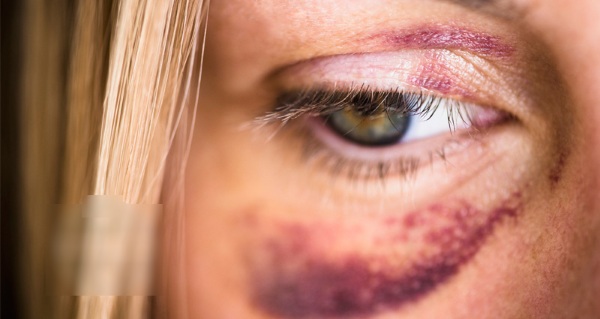
How many procedures are needed for a treatment?
The number of procedures depends on the complexity of the problem area. The deeper the vessel is located, the wider it is, the more procedures will be needed. A small superficial capillary or a small spider veins can disappear after one session, but more often they are required. So, to remove an extensive vascular network, a course of 4-5 procedures is needed.
Terms and features of rehabilitation
Laser coagulation does not require a long recovery period. The vessels brighten immediately, but the skin turns red after the session, puffiness appears - these phenomena disappear in a day. However, when treating large and complex areas, it can take from a week to 3 months for the complete disappearance of all manifestations.
After the procedure, the doctor may prescribe the application of some kind of healing ointment to the treated skin for several days. The formed crusts should not be touched: they will fall off on their own in 6-7 days. During the day, do not apply makeup and cleanse the skin with an alcohol solution.
Some additional regulations must be observed:
- you can not wash your face with hot water for a week;
- you cannot use scrub and peeling for two weeks;
- exclude visits to the sauna and bathhouse also for two weeks;
- use sunscreen with SPF 50 for a month;
- do not drink alcohol for several days: it dilates blood vessels;
- follow the individual prescriptions given by your doctor.
In general, the result of treatment is determined by the localization, area and color of the affected vessels, the depth of their occurrence. The age of the patient matters.
Possible complications and consequences
The adverse effects are usually minimal and short-lived. Complications arise when the patient does not follow the recommendations or the doctor's low qualifications.
They can be as follows:
- Puffiness persisting for more than a day. In this case, you need to take an antihistamine and apply cooling compresses. Keep the compress for no more than 15-20 seconds, then pause.
- Pigmentation changes persist for 2-3 months.
- Long-lasting healing crusts and scars. This is caused by burns resulting from an incorrectly selected force of the beam.
- A slight increase in body temperature.
- Hematomas.
In addition, if the procedure is not carried out correctly, telangiectasias can recur. During therapy, the laser beam must damage the surface of the inner walls of blood vessels (endothelium).It is important to select the radiation of such strength so that there is no perforation of the vessel.
However, in this case, the destruction of the endothelium must be complete so that new channels do not form under the influence of blood flow. Otherwise, the dilated vessel may protrude again. Treatment with a competent doctor can significantly reduce the likelihood of complications.
Price table: the cost of the procedure in Moscow, St. Petersburg and regions. How to choose a clinic
The amount that will cost to get rid of vascular pathologies on the face depends on the area of the lesion and the number of procedures.
Selective prices for one laser coagulation procedure in some cities of Russia:
| City, clinic | Land area | Price |
| Moscow, "Laser Doctor" | 1 sq. cm | RUB 1100 |
| St. Petersburg, New Skin Clinic | 1 sq. cm | RUB 900 |
| Nose | RUB 3000 | |
| Cheeks | RUB 4500 | |
| Full face | RUB 6000 | |
| St. Petersburg, "Laser Doctor" | 1 sq. cm, face | 1000 RUB |
| Samara, "Aesthetics" | Nose wings | 2000 RUB |
| Cheeks | 4000 RUB | |
| Face | RUB 4500 | |
| Yekaterinburg, Medical Center "Chance" | Nose | RUB 3000 |
| Cheeks | RUB 6000 | |
| Single vessel, face | RUB 500 |
For the treatment to be successful, you should choose a clinic with a good reputation. Removal of capillaries using laser coagulation is one of the most effective and less traumatic methods of getting rid of vascular “patterns” on the face.
The painlessness and near-immediate results have made the laser the preferred solution for cosmetic problems associated with vasodilatation.
Author: Anna Pavlova
Article design:Lozinsky Oleg
Video about capillary removal on the face
Removal of blood vessels on the face with a laser, before and after:

